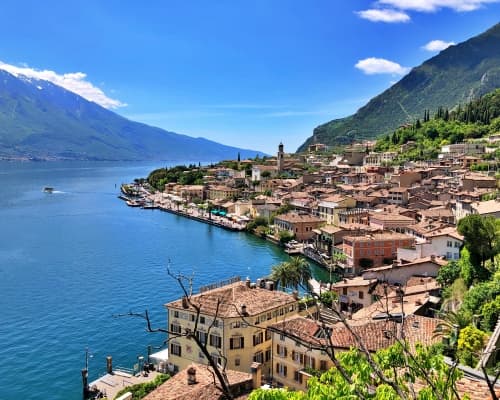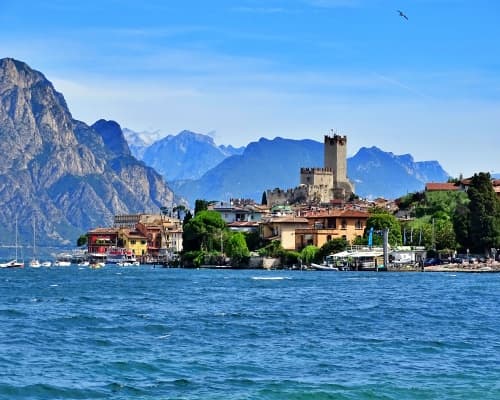The municipality of Ledro
Discover the wonders of Ledro Valley; its lake nestled between the mountains of Trentino and the ancient pile dwelling villages.
Located in the Trentino-Alto Adige region in the province of Trento, the municipality of Ledro extends along the valley of the homonymous Lake Ledro to the shores of the nearby Lake Garda.
The municipality was established following a popular referendum held on 30 November 2008 among the inhabitants of the previous six municipalities: Bezzecca, Pieve di Ledro, Concei, Molina di Ledro, Tiarno di Sopra and Tiarno di Sotto.
Geographically, the Ledro Valley stretches between the Chiese Valley to the west and the Riva Lowlands to the east, connecting the two mountain groups of Catione to the south and Cadria to the north. It is located in the southern part of Trentino, on the border with the province of Brescia. Its surface area is about 160 km2, bordered by a line of mountain ridges about 60 km long.
The people of Ledro, who had lived in the mountains for over two millennia, were initially ruled by the Romans. The village of Locca housed the Municipium, in which was located the Rector Locorum, the civil authority with administrative tasks. In Tiarno di Sotto was the Castellum, the seat of Roman authority, with the Centuria led by the Centurion, having military, fiscal and judicial functions.
Later, when the barbarians invaded the area, Rome's power decreased and the people of Ledro were forced to protect the mountain passes on their own. This situation strengthened the social bond between the people, who gained more autonomy over the years.
In more recent times, during the First World War, the Ledro Valley belonged to the Austro-Hungarian Empire and bordered the Kingdom of Italy. After Italy entered the war against Austria-Hungary, the Ledro Valley was the front between two armies, the Italians to the south and the Austro-Hungarians to the north.
This situation seriously endangered the lives of civilians and therefore the inhabitants of the valley had to leave their homes. The evacuees, mostly women, children and the elderly, set off on foot for the Riva del Garda train station and after a few days' journey, they arrived at some places in Bohemia and Moravia.
With the men serving at the front, the camps needed a lot of workforce and the Italian women showed great commitment from the very beginning. In this way, the people from Ledro gained the trust of the Bohemians, learned their language and forged strong bonds of friendship. When the war ended, in 1918-1919, after almost four years of absence, the people of Ledro finally returned to their homes in Ledro Valley.
Curious fact - On 28 June 2008, almost 90 years after the exile of the people from Ledro to Bohemia, today the Czech Republic, the Ledro Valley administrations established a twinning pact between the six municipalities of the Ledro Valley and the eight Czech municipalities that welcomed the refugees (Buštěhrad, Chyňava, Doksy, Milín, Nový Knín, Příbram, Ptice and Všeň).
What to see: the Ledro Valley villages
The Ledro Valley is certainly one of the most beautiful and suggestive valleys in Trentino, situated between Lake Garda and the Dolomites. It is an ideal place for people who love nature, history and culture, who can lose themselves in unspoilt natural landscapes and small villages where time seems to stand still.
Biacesa di Ledro is the first village you reach. Located at an altitude of 660 metres, it takes its name from the ancient Latin term 'bis caesa' literally 'doubly severed', in reference to the famous Ponale road and the road leading to Lake Ledro.
In this town, it is worth visiting the San Giovanni church, the Sant'Antonio church and the Defensionmauer, a tunnel with openings carved into the heart of the mountain, from which Austrian soldiers controlled the valley during the Great War.
Prè di Ledro is a town just over a kilometre from Biacesa and situated at an altitude of 488 metres. Among the peculiarities that distinguish this small village is that for some months of the year (from 11 November to 5 February) it does not receive direct sunlight, being located at the bottom of a valley.
You can visit the church of San Giacomo Maggiore and the Fucina de le broche, where you can see the production process of shoe nails (the broche), which until the middle of the last century were used to reinforce the soles of shoes.
Molina di Ledro is a town located at an altitude of 650 metres on the eastern shore of Lake Ledro. Its name derives from the many mills that in past times stood along the course of the Ponale torrent.
The main attraction of this town is undoubtedly the famous Lake Ledro Pile-Dwelling Museum. Built in the 1970s, it was initially a simple repository of artefacts, but over time it evolved into the splendid museum centre that we can visit today. It houses numerous artefacts found in the area, testifying to the millennial past of this region. On the shores of Lake Ledro about 4,000 years ago, there was a pile-dwelling village.
In 1929, the remains of more than 10,000 wooden piles, dating back to the Bronze Age, were discovered after the lake water subsided. Today the museum houses a faithful reproduction of the ancient pile-dwelling village outside, showing visitors how our ancestors lived. The Lake Ledro archaeological site is part of the Prehistoric Pile-Dwelling Sites of the Alps, declared a UNESCO World Heritage Site in 2011.
Curious fact - The famous poet and translator Andrea Maffei was born in Molina di Ledro in 1798.
Mezzolago is a town located at an altitude of 665 metres, about 3 kilometres from Molina, on the shores of Lake Ledro. It is called the "pearl of the lake" due to its special position, exposed to the sun and sheltered from the wind. Mount Cima d'Oro and Mount Cima Parì rise at its feet.
Curious fact - In 1928, the famous poet Gabriele D'Annunzio came to Mezzolago, charged to set off the last charge of explosives needed to open the water channel connecting Lake Ledro to the electrical power station of Riva del Garda.
Pieve di Ledro lies at an altitude of 660 metres on the west shore of Lake Ledro. The town houses the seat of the municipality of Ledro and plays an important political and religious role for the entire valley. Its main attractions include the photographic route "La memoria in mostra", the Church of Annunciazione, the Oratorio di San Giuseppe and the Museo farmaceutico Foletto. The latter exposes various period material used in the production of medicines, liqueurs and syrups based on herbs and fruits from the Ledro Valley.
Bezzecca lies at an altitude of 697 metres, about two kilometres away from Pieve di Ledro. Its name derives from the Latin term "bis secta", meaning "cut in two". The inhabited centre follows the course of the Assat torrent, which divides the town into the districts of Villa and Lutta.
To this place is linked a very important episode of Italian history. It was here, on 21 July 1866, that a battle was fought between the Garibaldini and the Austrians, the day on which Giuseppe Garibaldi pronounced his famous "Obbedisco", in response to Vittorio Emanuele II ordering him to leave Trentino. Bezzecca has not forgotten these events and commemorates them in the names of the streets and squares, but also in the traces of bombings still visible on some buildings.
Among the main tourist attractions are the Museo garibaldino e della Grande Guerra, Santo Stefano hill with trenches dating back to the First World War and the nearby military shrine, the churches of Santa Lucia and Santo Stefano.
Curious fact - In 1726, the giant Bernardo Gigli, nicknamed "el Popo", was born in Bezzecca. He measured the extraordinary height of 2 metres and 60 centimetres.
Concei is a hamlet of the municipality of Ledro, located in the Val Concei, at an altitude of 750 metres. Divided into the three villages of Locca, Enguiso and Lenzumo, it is certainly a perfect place for those who love nature and long walks.
Among the main tourist attractions in Val Concei, we recommend a visit to the church of San Martino in Locca, the church of Presentazione di Maria in Enguiso, the church of San Silvestro in Lenzumo and finally a pleasant hike on the nature trail along the valley floor.
Tiarno di Sotto and Tiarno di Sopra, located respectively at 728 and 749 metres of altitude, are the two main towns of the Val D'Ampola, a beautiful natural valley that includes the Biotope of Lake Ampola. Their name derives from the dialect word 'tia', which in local slang indicates the pine wood once used to make pitch. Tiarno split into Tiarno di Sopra and Tiarno di Sotto in the 11th century.
Obviously, also this final area of the vast territory of the municipality of Ledro is worth an exploration. We recommend a visit to the church of San Bartolomeo, the church of Santi Pietro e Paolo and the church of Santa Croce. Other characteristic places in the area include the suggestive Gorg d'Abiss waterfall, the Bugatini mill, the Roman bridge at Croina, the Tremalzo nature site and the Bocca Caset pass.
What to do: landscapes and trails in Ledro Valley
The Ledro Valley is an ideal destination for those who love sport and life in the open air. In this area there are more than 200 kilometres of routes suitable for mountain biking, divided between forest roads, paths and ancient mule tracks. At the bottom of the valley there is a cycle path that connects Lake Ledro to Lake Ampola and several secondary roads that can be travelled on bicycle.
Cycling enthusiasts should not miss the ascent to Monte Tremalzo. You can choose to ascend along the asphalted road that starts from Lake Ampola and climbs up to the pass. Alternatively, you can choose one of the routes with mixed ground that lead from Ledro Valley to a military road, built by Italian soldiers during the Great War. The latter is a very evocative route that crosses the entire southern side of the valley.
Among the routes on the north side, one of the most characteristic is the path that goes to Passo Trat and Rifugio Nino Pernici. It starts from Lenzumo and follows an uphill mountain road. On reaching the refuge, it is possible to return to Ledro Valley using two forest roads, or to descend towards Riva del Garda.
Another popular cycle route, known by an increasing number of tourists, is the one that connects Lake Garda with Lake Ledro. Starting from Riva del Garda, we climb along the path of the old Ponale trail, until 1995 the main artery of communication between the two lakes. At the entrance of the Agnese tunnel, we cross the bridge to Pregasina and continue along the path on the right that leads to Prè.
After passing the church, we continue along a mostly asphalted road, but with some rather steep sections, as far as the Molina di Ledro sports field. From this point it is possible to continue along the state road, or along the southern shore of the lake to Pieve di Ledro. The cycle path continues on the left side of the state road passing Bezzecca, ending the route in Tiarno di Sopra.
The Ledro Valley is also a perfect place for people who love long walks, trekking and hiking in nature. The considerable altitude range, from 65 m of Lake Garda to 2254 m of Monte Cadria, guarantees ever-changing views and a wide choice of routes suitable for all seasons. Those who prefer a quieter walk can choose the Lake Ledro tour, an itinerary also suitable for families with children, but always exciting and pleasant to hike.
Also very suggestive and artistically engaging is the path through the Pur pine forest. Following the Assat torrent, it is possible to admire the numerous artworks of the Ledro Land Art project, later arriving at Malga Cita. Among the possible alternatives, we recommend the Val Concei nature trail. This path is suitable for everyone and allows a total immersion into nature. From Pieve, you can alternatively take the 9-km cycle-pedestrian path to Lake Ampola, passing through Tiarno di Sotto and Tiarno di Sopra.
During the summer season, Lake Ledro also offers numerous recreational opportunities for water sports enthusiasts. At the numerous beaches and various sports centres, it is possible to practice swimming, windsurfing, sailing, canoeing, wakeboarding and the ever more popular SUP (Stand Up Paddle) in complete safety. Water sports are also an opportunity to get in touch with nature, observe the area from a different perspective and experience unique emotions.
Also worth mentioning is the presence of a beach for dogs. In the southern part of Lake Ledro, a portion of the Pur beach has been equipped to allow people to bring their four-legged friends to the lake.
The Ledro Valley offers a wide range of opportunities to the many tourists who choose it for their holidays every year. An important role is also played by the quality of the food and the numerous typical products that can be tasted in this valley. Each restaurant and refuge has its own speciality and style, but they all share a passion for quality and hospitality.
We strongly suggest to all tourists, who love Lake Garda like us, to also visit the nearby Ledro Valley and let themselves be enchanted by this Italian wonder.
Ledro Valley image gallery
Click on the button below to open the image gallery.
Map of Ledro Valley tourist attractions
Click on the button below to open the detailed map.
Ledro - FAQ
- Valle di Ledro cycle path: runs parallel to the road along the Ledro Valley to Lake Ampola. This path is about 10 km long and suitable for everyone.
- Pieve di Ledro - Riva del Garda: this itinerary starts in Pieve di Ledro and runs parallel to the lake down to Riva del Garda, passing along the stunning Ponale Road. This route is just under 17 km long with medium difficulty.
- Lake Ledro ring tour: this itinerary starts in Molina di Ledro and goes around the lake. This path is about 10 km long and suitable for everyone.
- Pieve di Ledro Beach
- Molina di Ledro Beach
- Mezzolago Beach
- Pur Beach
- Parking Lago di Ledro (Via Maffei, 50)
- Parking Via di Pastei, 13
- Parking Besta 1 (Via Maffei, 127)
- Parking Besta 2 (Via Maffei, 123)
- Parking Via Nuova, 1
- Parking Mezzolago (Via S. Michele, 18)
- Parking Via Nuova, 31
- Parking Via Příbram
- Parking Lago Pieve (Viale A. Foletto, 5)
- Parking Via Val Maria
- Bezzecca: every Monday (from June to September).
- Pieve di Ledro: every Thursday (from June to September).
- Tiarno di Sotto: every Friday.
- Molina di Ledro: every Saturday (from July to September).
Other places on Lake Garda
Keep exploring other beautiful towns near Ledro.

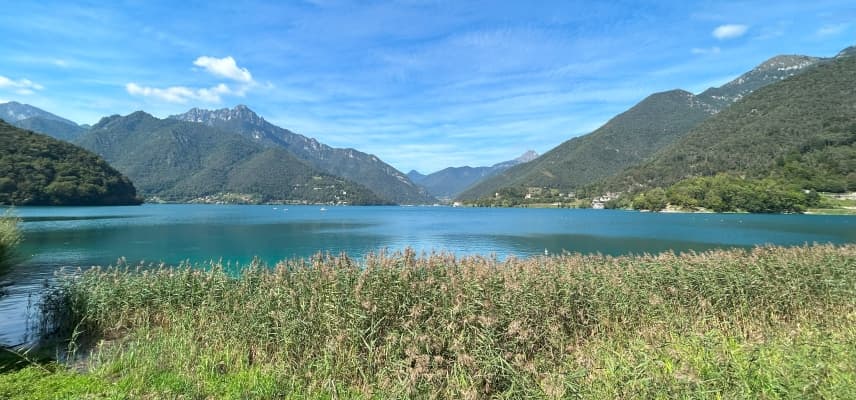
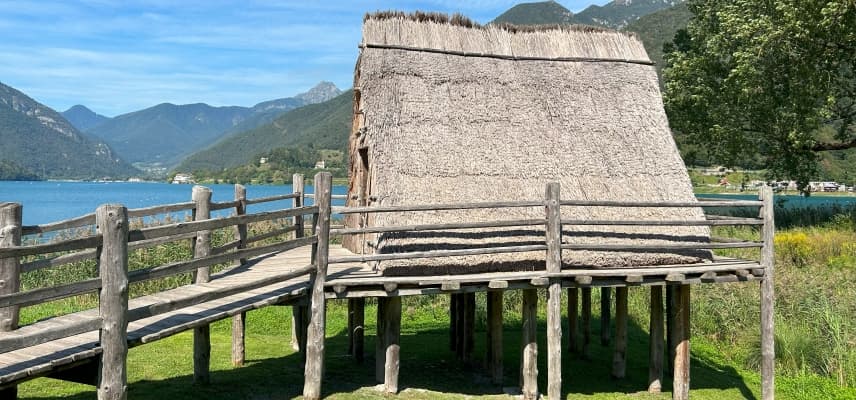
 16 km
16 km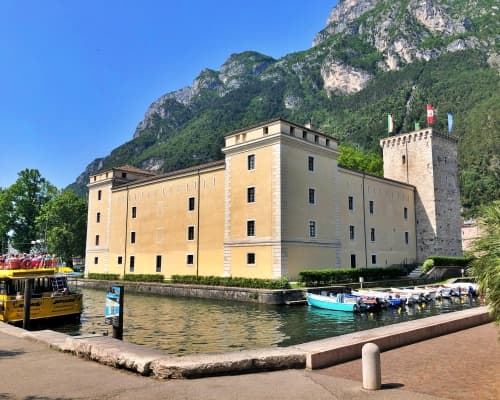
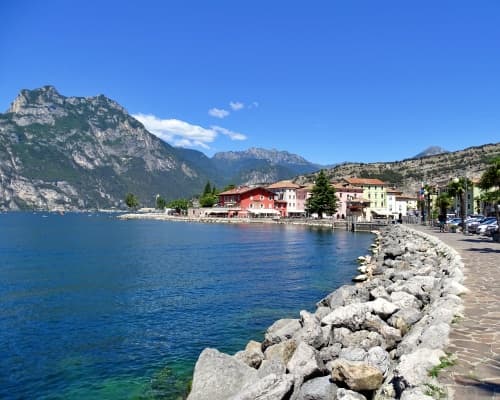
 26 km
26 km